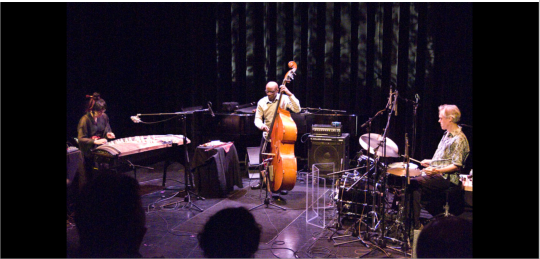#miyah masaoka
Text
Brew—Heat & Between Reflections (Clean Feed)


Brew is a trio that has existed since the late 1990s, when Miya Masaoka and Reggie Workman invited Gerry Hemingway to join their duo. They gigged and recorded enough around that time to put together a debut album, Brew, but never managed to line up its official release. They kept working together, and during a visit that Hemingway made back to New York (he currently lives and teaches in Switzerland) in late 2019 they checked into Acoustic Recordings for a day to make another record. Apparently Hemingway’s robust ongoing relationship with the Portuguese Clean Feed label propped the door of opportunity open wide enough to turn one album into two, so now we can consider 20 years in the history of a band you might not even have known existed.
Before considering the merits of Brew and Between Reflections as recordings, this has to be said — what a band! The unlikeliness of its line-up — one experimental koto player, one bassist who has John Coltrane, Art Blakey, and the New York Art Quartet on his c.v., and one drummer who juggles concepts, meters and sounds in settings as diverse as a piano trio playing Billy Strayhorn tunes and a band led by Anthony Braxton — is easily forgotten once you hear the depth of their rapport. Each musician places their distinct understanding of their instrument at the service of a mercurial collective sound, yielding consistently thrilling results.
Take “Message From The Outside,” from Brew. You could say that it’s just a sustained groove, and you wouldn’t be wrong. But to hear how the sound swells as Masaoka’s strings stir sonic whirlpools within Hemingway’s constantly mutating patterns, and how Workman’s bowing slices through them without knocking a beat out of place, is to hear how much masters can do with the essentials. Or consider “One For Walt Dickerson,” on which Hemingway switches to vibes and Masaoka distorts her strings like a rock guitarist. The novelty of Masaoka’s sounds in proximity to the solemn vibe that Hemingway and Workman establish is undeniable, but what registers is the patience with which the music unfolds, and the sense of eeriness that its juxtapositions impart.
The combination of recording sessions that span twenty-one years tempts the listener to consider how the group may have changed over that time, and one can definitely hear changes in recording technology, and effects, and inclinations towards multi-instrumentalism. But what persists is how well these musicians facilitate the manifestation of an uncommon common sound.
Bill Meyer
#brew#heat and between reflections#clean feed#bill meyer#albumreview#dusted magazine#jazz#miyah masaoka#reggie workman#gerry hemingway#Bandcamp
3 notes
·
View notes